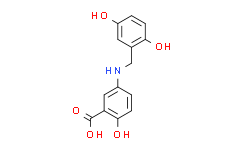| Cas No.: | 125697-93-0 |
| Chemical Name: | 5-(2,5-Dihydroxybenzylamino)-2-hydroxybenzoic Acid |
| Synonyms: | 5-(2,5-Dihydroxybenzylamino)-2-hydroxybenzoic Acid;Benzoic acid,5-[[(2,5-dihydroxyphenyl)methyl]amino]-2-hydroxy-;Lavendustin c;COMPOUND 5;HDBA;N-(2-((2-((4Z,7Z,10Z,13Z,16Z,19Z)-DOCOSA-4,7,10,13,16,19-HEXAENAMIDO)ETHYL)DISULFANYL)-2-METHYLPROPYL)NICOTINAMIDE;NSC 666251;Lavendustin C (HDBA);5-(2,5-DIHYDROXYBENZYLAMINO)SALICYLIC ACID;5-(N-2,5-DIHYDROXYBENZYL)AMINOSALICYLIC ACID;5-(N-2',5'-DIHYDROXYBENZYL)AMINOSALICYLIC ACID;N-(2',5'-DIHYDROXYBENZYL)-5-AMINOSALICYLIC ACID;2-hydroxy-5-(2,5-dihydrobenzyl)aminobenzoic acid |
| SMILES: | C1=CC(=C(C=C1NCC2=CC(=CC=C2O)O)C(=O)O)O |
| Formula: | C14NO5H13 |
| M.Wt: | 275.2567 |
| Purity: | >98% |
| Sotrage: | 2 years -20°C Powder, 2 weeks 4°C in DMSO, 6 months -80°C in DMSO |
| Description: | Lavendustin C is a potent Ca2+ calmodulin-dependent kinase II (CaMK II) inhibitor with an IC50 of 0.2 µM. Lavendustin C inhibits EGFR-associated tyrosine kinase (IC50=0.012 µM) and pp60c-src(+) kinase (IC50=0.5 µM) [1][2].. |
| In Vitro: | Lavendustin C (Compound 5) shows potent inhibitory activity, and it may be the core structure responsible for inhibition of tyrosine kinase[1]. Lavendustin C (10-150 µM) inhibits tyrosine kinase-associated neutrophil degranulation and superoxide generation[3]. |
| References: | [1]. T Onoda, et al.Isolation of a Novel Tyrosine Kinase Inhibitor, Lavendustin A, From Streptomyces Griseolavendus. J Nat Prod. Nov-Dec 1989;52(6):1252-7. [2]. T J O'Dell, et al.Long-term Potentiation in the Hippocampus Is Blocked by Tyrosine Kinase Inhibitors. Nature. 1991 Oct 10;353(6344):558-60. [3]. H M Burt, et al. Inhibition of Crystal-Induced Neutrophil Activation by a Protein Tyrosine Kinase Inhibitor. J Leukoc Biol. 1994 Jan;55(1):112-9. |






















